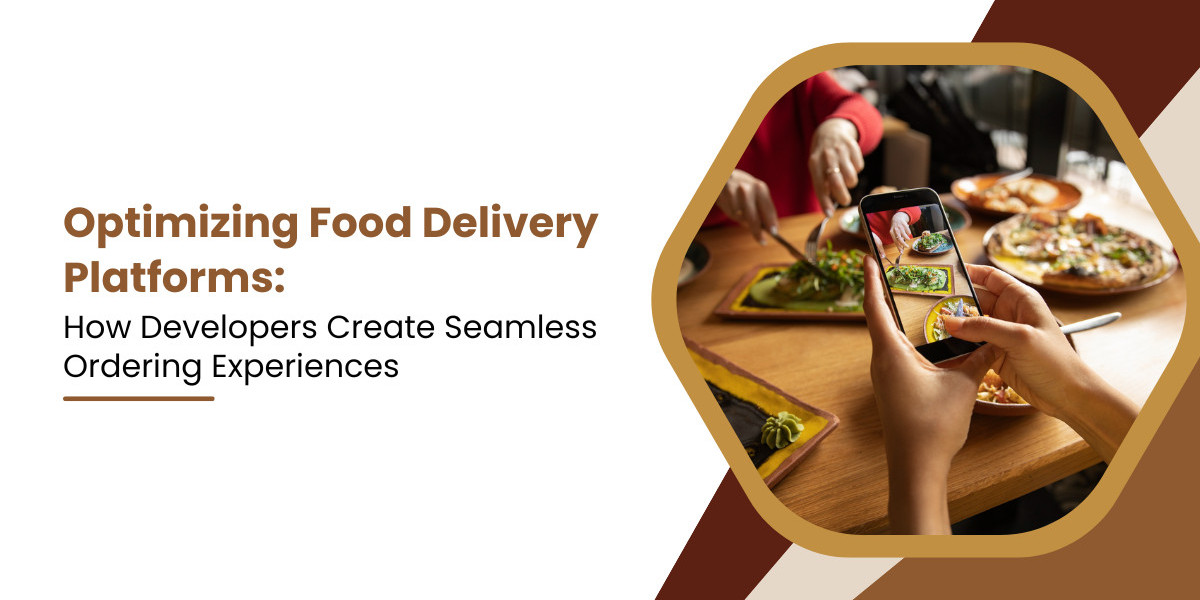The global food delivery market has experienced explosive growth in recent years, and this trend is only accelerating. In 2022, the global online food delivery market was valued at approximately $154.34 billion and is expected to grow at a compound annual growth rate (CAGR) of 11.51% from 2023 to 2030. As more customers opt for the convenience of ordering food online, businesses in the food delivery industry are under increasing pressure to provide seamless, user-friendly experiences. Food delivery app development companies play a crucial role in optimizing these platforms to ensure customers enjoy an effortless and satisfying ordering process.
The Importance of User Experience in Food Delivery Apps
In the competitive world of food delivery, user experience (UX) is a key differentiator. A smooth and intuitive app interface not only attracts users but also retains them. According to a Statista survey, 60% of online consumers abandon a purchase if the website or app is difficult to use. A clunky, slow, or frustrating ordering process can lead to negative reviews and customer churn.
To create the perfect ordering experience, it is essential to have a well-designed app that meets users’ expectations. This includes a clean and easy-to-navigate interface, fast load times, and a simple, step-by-step ordering process. Let’s break down the key features that food delivery app development companies should focus on when designing an optimized platform.
1. User Interface and Navigation Design
A well-structured UI is the cornerstone of a seamless user experience. The layout should be visually appealing yet functional. Here are some important elements to consider:
Clear and Intuitive Menu Layout
Users should be able to find their desired dishes quickly and easily. Categorizing menu items (e.g., appetizers, entrees, desserts) helps streamline the browsing process. Adding a search function also allows users to quickly locate specific dishes or restaurants.
Simplified Ordering Process
The ordering process should consist of clear steps. A good practice is to implement a “progress bar” that shows users where they are in the ordering process. This ensures transparency and reduces anxiety during checkout.
Easy-to-Use Filters
Allow users to filter food choices based on dietary preferences (vegan, gluten-free, etc.), price range, delivery time, and more. Filters help narrow down options and enhance the ordering experience.
Visual Appeal
Bright, high-quality images of food items are proven to attract users and improve the likelihood of orders. Visuals should be clear, realistic, and reflective of the actual food being offered.
2. Speed and Performance Optimization
Speed is a critical factor in any food delivery app. If the app is slow or unresponsive, users are more likely to abandon their orders and look for alternatives. According to a study by Google, 53% of mobile users abandon a site or app that takes longer than 3 seconds to load.
Fast Load Times
Optimizing the app’s performance by reducing load times is essential for retaining users. Using proper image compression, caching, and a minimalistic design approach helps improve speed without sacrificing functionality.
Smooth Transitions
The transition between screens should be smooth and fluid. Users should not experience any delays or glitches while navigating the app, especially when moving from the menu to checkout.
3. Seamless Payment Integration
A simple and secure payment system is crucial in food delivery app development. Users expect multiple payment options, including credit cards, debit cards, digital wallets, and even cash on delivery.
Multiple Payment Options
Allowing users to choose from a variety of payment methods can significantly improve their experience. For instance, services like PayPal, Apple Pay, or Google Pay offer ease of use and increased security.
Secure Payment Processing
Ensuring the safety of user data during transactions is essential. Food delivery apps must integrate secure encryption and comply with standards like PCI DSS (Payment Card Industry Data Security Standard) to protect sensitive information.
One-Click Ordering
Implementing a one-click ordering feature allows returning customers to quickly place an order without having to re-enter payment details. This feature greatly enhances convenience and encourages repeat business.
Also Read: Food Delivery Apps in Hospitality: Enhancing Guest Experience Digitally
4. Real-Time Order Tracking
One of the key features that can elevate the customer experience is real-time order tracking. Customers want to know exactly when their food will arrive, and providing them with this information can build trust and reduce anxiety.
GPS-Based Tracking
Integrating GPS-based tracking allows users to see the exact location of their order in real time. Many food delivery apps already include this feature, and it significantly improves transparency for users.
Estimated Delivery Time
Clearly displaying the estimated delivery time (and keeping it updated in real-time) helps set expectations and prevents frustration. If there are any delays, sending notifications can keep the user informed and provide alternatives (such as a coupon for future orders).
Order History
Allowing users to access a history of their past orders makes it easier for them to reorder their favorite meals quickly, saving time and improving convenience.
5. Push Notifications and Customer Communication
Effective communication is a vital part of the food delivery experience. Push notifications are an excellent way to keep users informed and engaged throughout the ordering process.
Order Updates
Send notifications when an order is confirmed, being prepared, and out for delivery. This reassures users that their food is on its way and enhances the overall experience.
Promotions and Offers
Push notifications can also be used to send personalized promotions, discounts, and offers. For example, offering users a discount on their next order can encourage them to make repeat purchases.
Customer Support Integration
In case of issues, a built-in chat support feature allows users to reach customer service instantly. Offering live chat support during the ordering process helps resolve problems quickly, leading to improved customer satisfaction.
6. Backend Optimization and Scalability
A fast, reliable, and scalable backend is the backbone of any successful food delivery app. Here are some key elements of backend optimization that should be prioritized:
Efficient Database Management
Effective database management ensures that user data, order details, and restaurant information are stored securely and can be accessed quickly. Optimized database queries help improve app performance.
Scalability
As your food delivery platform grows, it’s important that the backend can handle increased traffic and order volumes without compromising on speed. Implementing cloud-based solutions like AWS or Google Cloud ensures scalability.
Integration with POS Systems
Integrating your food delivery app with restaurant POS (Point of Sale) systems allows seamless communication between the app and the kitchen, ensuring faster order processing and reducing errors.
7. Building Customer Trust Through Reviews and Ratings
Customer reviews and ratings play a significant role in building trust and improving the app’s credibility. A Nielsen report reveals that 92% of consumers trust recommendations from friends and family, and 70% trust online reviews.
User-Generated Content
Allow customers to leave reviews and rate their experience after the delivery. Displaying these reviews within the app can help users make informed decisions when choosing a restaurant or food item.
Respond to Feedback
Actively responding to customer feedback, both positive and negative, shows users that you value their opinions. It also helps foster a sense of community and builds customer loyalty.
8. Personalization Features
Personalization is a great way to enhance the user experience and encourage repeat business. By offering personalized recommendations and customizing the user interface based on preferences, developers can create an app that feels more tailored to each user’s needs.
Personalized Recommendations
Food delivery app developers can use machine learning algorithms to suggest food items or restaurants based on users’ past orders, preferences, or location.
Customizable Profiles
Allow users to create profiles that store their dietary preferences, favorite orders, delivery addresses, and payment methods for a more personalized experience.
Conclusion
Creating the perfect ordering experience in a food delivery app requires a comprehensive approach that balances user-friendly design, seamless functionality, and robust backend infrastructure. Food delivery app development companies play a crucial role in ensuring that these elements come together to provide a smooth, intuitive platform for users. By focusing on UI design, real-time tracking, payment integration, and customer communication, developers can optimize food delivery apps to meet the demands of modern consumers. As competition in the food delivery industry continues to grow, investing in a well-designed app is essential for staying ahead and building lasting customer loyalty.








